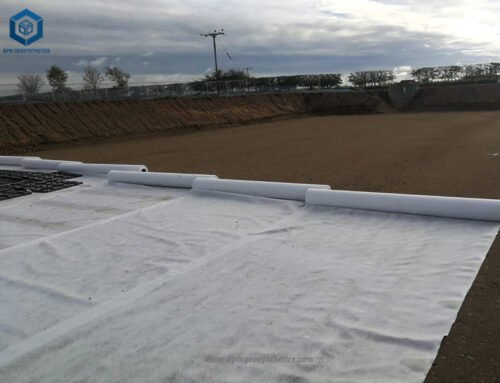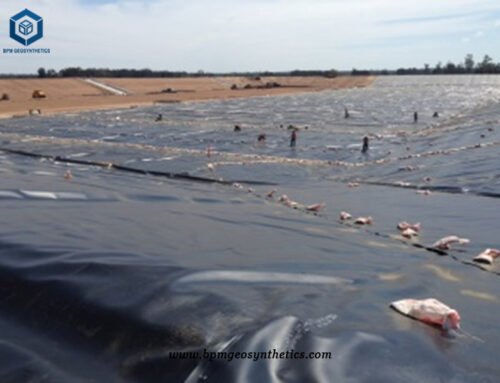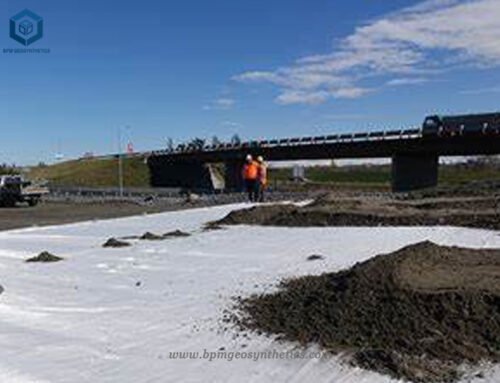HDPE impermeable membrane, also known as HDPE geomembrane, is the geotechnical material that is widely used as the anti seepage lining material in water or waste containment applications. BPM high-quality HDPE geomembrane is made of high-density polyethylene (HDPE) raw materials with carbon black, anti-aging agents, anti-ultraviolet absorbers, stabilizers and other auxiliary materials. The HDPE impermeable geomembrane liner have excellent resistance Ultraviolet radiation, and is suitable for outdoor construction sites. HDPE impermeable membrane has good anti-leakage performance, excellent chemical resistance, excellent environmental stress crack resistance, high cost performance, good overall continuity, convenient construction and environmental protection. BPM HDPE impermeable membrane is widely used in various occasions including waste treatment, water treatment, aquaculture, industrial projects, energy projects and mining projects and other industries.
1. What Are Benefits of HDPE Impermeable Membrane?
HDPE (high-density polyethylene) impermeable membranes offers several benefits in various applications. Here are the key advantages of HDPE impermeable membranes:
1.1 Environmental Stress Cracking Resistance
HDPE geomembranes exhibit excellent resistance to environmental stress cracking. This property ensures the membrane’s durability and integrity even in challenging conditions.
1.2 Temperature Resistance
HDPE geomembranes have a wide operating temperature range, from -60°C to +60°C. This allows them to withstand extreme temperatures without compromising their performance.
1.3 Long Service Life
HDPE geomembranes have a long service life that can extend up to 60 years with proper installation and maintenance. This longevity ensures cost-effectiveness and reduces the need for frequent replacements.
1.4 Superior Anti-Seepage Properties
HDPE impermeable geomembranes provide exceptional anti-seepage capabilities that surpass ordinary waterproof materials. This quality makes them highly effective in preventing water leakage and contamination.
1.5 Tensile Mechanical Properties
HDPE geomembranes possess high tensile strength and excellent elasticity, making them suitable for accommodating the expansion or contraction of the base surface. This flexibility helps maintain the integrity of the geomembrane even in dynamic conditions.
1.6 Chemical Stability
HDPE geomembranes exhibit excellent chemical stability, making them suitable for applications involving sewage treatment, chemical reaction tanks, landfills, and more. They offer resistance to a wide range of chemicals, including acids, alkalis, and various chemical media.
1.7 Corrosion Resistance
HDPE geomembranes demonstrate superior corrosion resistance to high and low temperatures, asphalt, oil, tar, acid, alkali, salt, and over 80 types of strong acids and alkalis. This property ensures long-term performance and durability in challenging environments.
1.8 Mechanical Strength
HDPE geomembranes possess good mechanical strength, with a high tensile strength at break of 28 MPa and an elongation at break of 700%. This strength ensures the membrane’s ability to withstand external forces and stresses.
1.9 Non-Toxic and Environmentally Friendly
The materials used in HDPE impermeable membranes are non-toxic and environmentally friendly. They undergo ordinary physical changes during the anti-seepage process, without producing any harmful substances. This makes HDPE membranes a safe and sustainable choice for applications such as environmental protection, aquaculture, and drinking water tank liners.
HDPE impermeable membranes offer a range of benefits including resistance to environmental stress cracking, temperature durability, long service life, superior anti-seepage properties, mechanical strength, chemical stability, corrosion resistance, non-toxicity, and environmental friendliness. These advantages make HDPE geomembranes highly versatile and suitable for a wide array of applications.

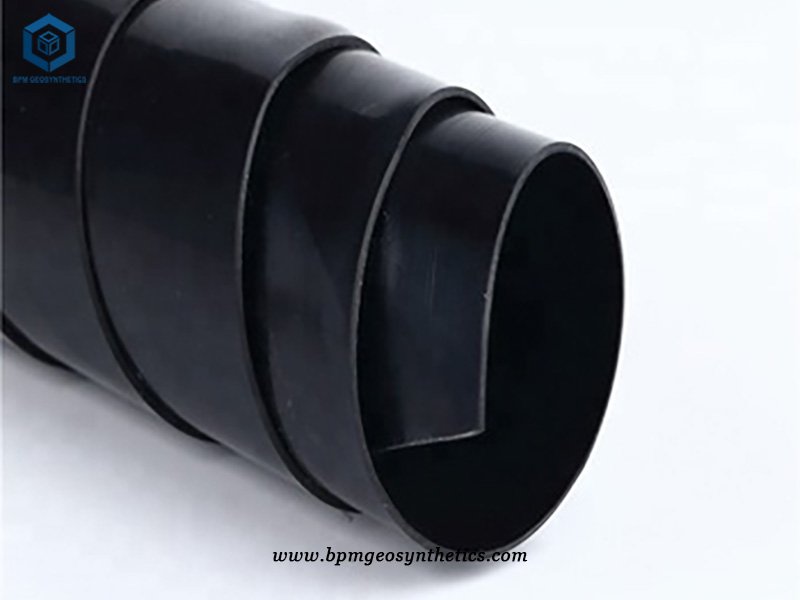
2. How To Make HDPE Impermeable Membrane?
The production process of HDPE impermeable membranes typically involves the use of a 3-layer blow molding machine. Here is a general overview of the steps involved in making HDPE impermeable membranes:
2.1. Raw Material Preparation
High-density polyethylene (HDPE) resin is selected as the primary raw material for manufacturing the impermeable membrane. The resin is processed and prepared for the blow molding process.
2.2. Extrusion and Blow Molding
The HDPE resin is fed into the 3-layer blow molding machine, which consists of an extruder and a blow molding unit. The resin is melted and extruded through a die to form a continuous tube or bubble of molten HDPE.
2.3. Cooling and Stabilization
The molten HDPE bubble is passed through a cooling system, which utilizes air or water to rapidly cool and stabilize the film. This process helps to solidify the HDPE and ensure dimensional stability.
2.4. Bubble Control and Sizing
The size and thickness of the HDPE bubble are controlled by adjusting the air pressure inside the bubble and the speed of the cooling system. This step ensures the desired thickness and dimensions of the impermeable membrane.
2.5. Flattening and Winding
The cooled HDPE bubble is then flattened and wound onto rolls or spools. This allows for easy handling and transportation of the impermeable membrane.
2.6. Quality Control
Manufacturers typically perform quality control checks during the manufacturing process. These checks may include electrical spark testing to detect pinholes and defects in the membrane.
Once the HDPE impermeable membrane is manufactured, it can be transported to the installation site. During the installation process, it is essential to ensure the integrity of the gasket and cover to maintain the effectiveness of the impermeable system. Additionally, electrical lining integrity testing is performed during installation to ensure the system’s safety and confirm the integrity of the membrane.
It’s important to note that the specific manufacturing process may vary depending on the equipment used, the desired thickness and dimensions of the membrane, and the manufacturer’s specifications.
3. Case Anylysis of HDPE Membrane for Australian Sewage Treatment Project
- Construction site – Australia
- Products used – HDPE geomembrane with a thickness of 1.5mm
- Application – Sewage treatment
- The area of geomembrane used in construction: 18620㎡
- The size of each roll of HDPE geomembrane is 7m*50m
The sewage treatment plant is crucial for receiving and treating sewage from residents and businesses in the area. It helps address the pollution caused by various non-toxic inorganic salts found in detergents, sewage, and urban waste. Domestic sewage contains nitrogen, phosphorus, sulfur, and pathogenic bacteria, which are major contributors to water body pollution. With increasing population density, the discharge of domestic sewage is rising.
Chemical companies often need to temporarily store sewage generated during equipment transformations or temporary construction. If the treated sewage fails to meet national standards, it must be stored until it can be discharged after meeting the required treatment criteria. This requires the construction of temporary sewage treatment tanks capable of storing large quantities of sewage.
Leakage from sewage treatment plants can cause severe environmental pollution. Contaminated soil becomes saline and toxic, posing health risks due to parasites and pathogenic bacteria. Infiltration can also contaminate groundwater, eventually entering the human food chain and causing significant harm to human health. Customers are eager to find a suitable solution to address this problem promptly.
4. How To Use HDPE Impermeable Membrane Australia For Sewage Treatment Project
When constructing the reservoir, the engineers of the project wanted a reliable and long-life geosynthetic product. The engineer wanted to protect the HDPE impermeable membrane from mechanical damage and thermal expansion and contraction through the cost and maintenance of the cover layer. In addition, people are also worried about the shrinkage caused by icing and temperature changes in winter.
After browsing the related products on our website, the engineer sent us an inquiry. We have a detailed understanding of the customer’s needs and read the construction plan provided by the customer. Therefore, BPM recommends HDPE geomembrane with a thickness of 1.5mm that meets the requirements of this project and consulting engineers. We sent him geomembrane samples, company certificates, product test reports and other information. After receiving the samples, the customers are very satisfied with our products.
HDPE impermeable membrane is a geomaterial with convenient transportation, convenient construction and short construction period. At the same time, the cost of the anti-seepage system is more than 30% lower than that of the traditional reinforced concrete anti-seepage structure. And HDPE geomembrane has strong acid and alkali resistance, anti-aging, anti-ultraviolet abilities, can be used quickly in various complex environments, and is durable.
HDPE geomembrane liner has high tensile mechanical properties. Its excellent elasticity and deformability make it very suitable for the expansion or contraction of the base surface. It can effectively overcome the uneven settlement of the base surface. Water vapor permeability coefficient K<=1.0*10- 13g.cm/c cm2.s.pa. Chemical stability-The impermeable membrane has excellent chemical stability and is widely used in sewage treatment, chemical reaction tanks, and landfills Field, tailings treatment. HDPE geomembrane is resistant to high and low temperature, asphalt, oil, tar, acid, alkali, salt and more than 80 kinds of strong acid and alkali chemical media. It is a good choice for sewage treatment tanks.
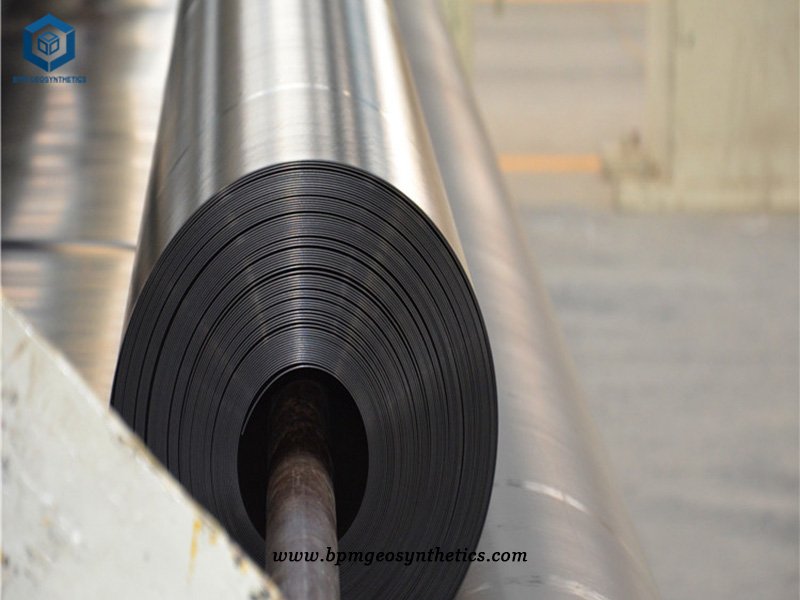
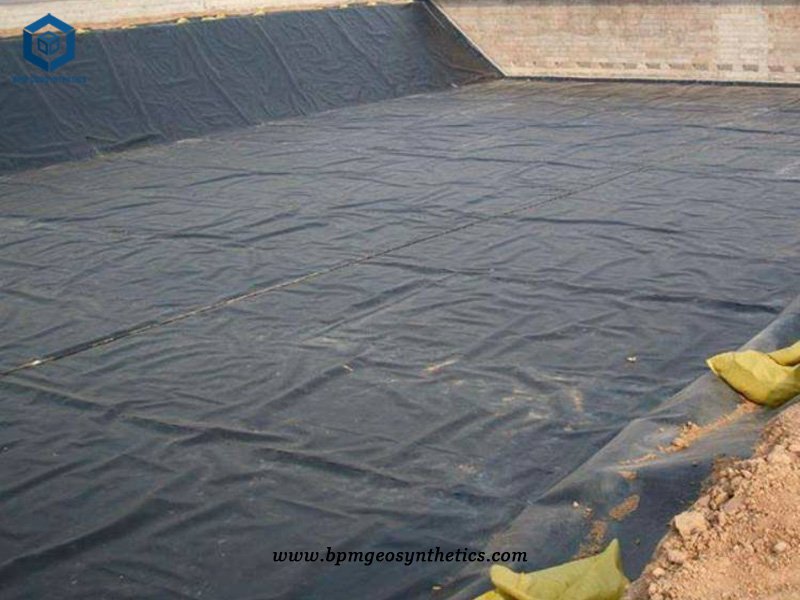
5. Conclusion
HDPE impermeable omembrane liner is convenient for transportation, convenient construction and short construction period. At the same time, the cost of the anti-seepage system is more than 30% lower than that of the traditional reinforced concrete anti-seepage structure. And HDPE geomembrane has strong acid and alkali resistance, anti-aging, anti-ultraviolet abilities, can be used quickly in various complex environments, and is durable.
The sewage treatment project has been in continuous operation since its completion. A small amount of maintenance and upgrades were carried out in this process, but no changes or changes were made to the lining system. Monitor shallow groundwater wells near the reservoir to determine the presence of wastewater to ensure the integrity of the containment system. This year’s inspection of HDPE geomembrane did not reveal any problems and signs of degradation or mechanical damage.
BPM Geosynthetics is the leading geomembrane manufacturer and supplier. Any questions, please contact us.


